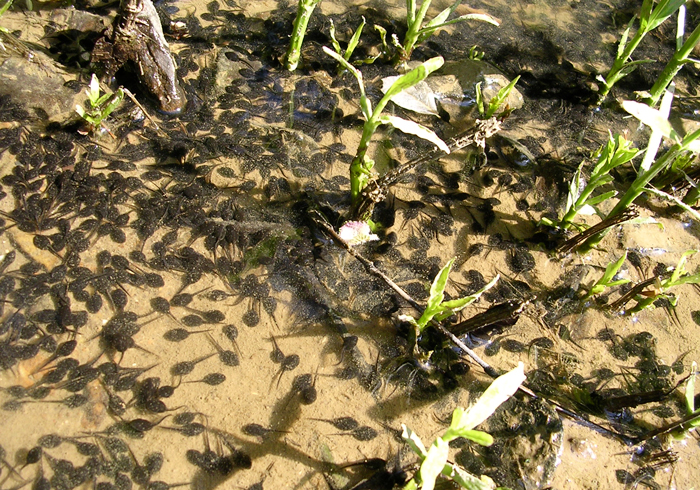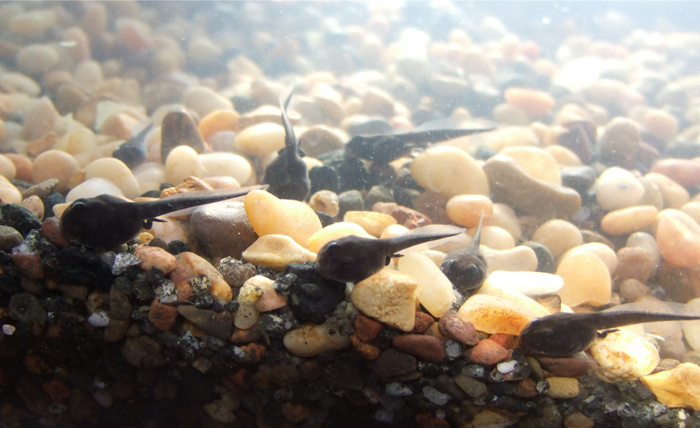Proper feeding is important for tadpoles as it supports their growth, development, and survival. It helps them transform into healthy adult frogs. You should remember that tadpoles’ diet is much different than that of adult frogs.
But, What to feed tadpoles? You can offer a wide variety of foods to them, such as vegetables like lettuce, cucumber, carrots, zucchini slices, or fruits like berries. Also, offering boiled egg yolk for protein, algae wafers or tablets in captivity, and insects are quite nutritious.
Tadpoles are curious eaters and may attempt to eat anything you provide. However, you must educate yourself about their dietary habits and offer a good diet for proper nutrition.
What to Feed Tadpoles at Home for Proper Nutrition?

Tadpoles, despite their early stage and small mouths, can devour different kinds of foods like veggies, fruits, insects, and more. Check out the ideal food options for the growing amphibians:
Feed Vegetables to Young Tadpoles
Tadpoles are mostly vegetarians. They find it suitable and convenient to eat leafy foods in the initial days of their lives. Therefore, you should also try to imitate their natural food habits.
- Lettuce: Lettuce is an ideal vegetable option for tadpoles as these leaves are suitable for their digestive system. However, you should avoid iceberg lettuce because of their low nutrition. Instead, feed your tadpoles more nutritious romaine lettuce.
- Cucumbers: This vegetable is rich in vitamins, minerals, and antioxidants. Tadpoles are easily attracted to floating cucumbers. Cucumbers contain a very low amount of sodium, which makes them an ideal food for tadpoles.
- Carrots: Tadpoles require strong eyesight, and the presence of a high amount of vitamin A in carrots can help with this. Cut the carrots into thin and small slices so that they can float on the water’s surface.
- Spinach: These leafy greens are high in energy with a very low amount of fat. It can also provide the tadpoles with minerals, vitamin C, and vitamin B.

How to Feed Vegetables to Tadpoles Properly?
You need to maintain a proper method when feeding vegetables so that the young amphibians can enjoy the benefits properly. Here is an instruction you can follow:
- Make sure the vegetables are free of pesticides. Any kind of pesticides or related chemicals are harmful to tadpoles.
- Wash the vegetables properly before giving them to the tadpoles.
- Slice vegetables into manageable pieces and ensure they are light enough to float on the water’s surface.
- Check on the water regularly. Stuffing the tank water with too many vegetables can result in contamination.
Naturally Grown Algae
In nature, most tadpoles are generalistic algae feeders. Algae is suitable for tadpoles’ small mouths and weak jaws. Besides, they are rich in protein and carbohydrates, which are important for the development and growth of tadpoles. They are easily available in ponds in abundance.
If you can manage healthy algae for your tadpoles in captivity, it will be a great addition to their diet.

How to Feed Algae to Tadpoles?
Collect algae and put them into the tank, and the tadpoles will be attracted. You must collect algae from natural water sources like ponds and storms. You can collect stones with algae and place them directly into the tank. You can also culture green algae in a tank or aquarium. Watch this video for help:
Boiled Eggs: Best Homemade Food
Boiled eggs are among the best homemade foods you can provide to your tadpoles. Some owners solely rely on boiled eggs for the nutrition of tadpoles in the early stages. Eggs are a good source of protein, which is crucial for proper development of tadpoles.
Additionally, the egg yolk contains vitamins and minerals that contribute to overall tadpole health. You can provide them with boiled eggs sometimes as a complementary food along with algae.
How to Feed Boiled Eggs to Tadpoles?
You should keep in mind the following instructions to ensure your tadpoles are being benefited by the eggs you provide.
- Boil the eggs properly and make sure the yolk becomes solid.
- Let the egg cool first before giving it to the tadpoles.
- Peel the boiled eggs carefully to ensure no shell remains attached, as it can be harmful to tadpoles.
- Cut the eggs into small, bite-sized pieces and distribute them evenly inside the tank.
- Remove uneaten egg pieces after some hours so that the water does not get polluted.
Introduce Insects for Protein
After a few days, some tadpoles are able to eat small insects like fruit flies and aphids. Insects are a good source of protein for these baby frogs. Feeding insects to your captive tadpoles increases their chance of survival.
You have to feed the tadpoles meat once they become carnivores. Otherwise, they may end up eating each other. Insects can meet their demand for meat.

How to Feed Insects to Tadpoles?
There are a few things you should keep in mind while feeding insects to tadpoles, such as:
- The insects should be soft-bodied. Fruit flies, small crickets, and mealworms are suitable options.
- Avoid catching insects from the garden or backyard, as they can contain diseases. Instead, purchase insects from pet stores.
- The size of the insects should not be bigger than the tadpoles. Smaller tadpoles require smaller-sized insects.
- Tadpoles usually enjoy living prey. However, if the tadpoles are weak, then you can offer them dead insects.
- Avoid overfeeding your tadpoles with insects. It can harm their health. You shall not feed them insects on a daily basis either.
- Some tadpoles may choose to remain vegetarian till they grow up. In such cases, you should not force them to consume insects.
Give Fruits to Increase Growth
Fruits are a good source of vitamins for tadpoles and can boost transformation into adult frogs. However, you should only give them fruits once they start to grow hind legs.
The sugar content of food is not good for tadpoles in their early stage. Fruits like bananas and ripe berries are ideal for them.
How to Feed Fruits the Right Way?
Follow these steps to offer fruits to your tadpoles properly:
- Wash the fruits properly to ensure no dirt or pesticide remains.
- Mash the fruits into small pieces to make them easy to eat for tads.
- Offer fruits in small amounts and observe the reaction of the tads. If they are not interested, stop giving them fruits.
- Give them different fruits only occasionally. It should not be their primary food source.
- Uneaten fruits should not remain for more than a day to maintain water quality.
What to Feed Tadpoles in a Pond?

You do not need to give extra food to tadpoles living in a pond. They will get enough food there. Algae grows in plenty in plants or on rocks that tadpoles can live on in a pond. When the tadpoles grow and become omnivores, they can eat tiny creatures like fleas in the pond.
If the pond is very new and there is not enough algae or plants, you can offer them lettuce and other leafy greens. You can feed them fish flakes for the necessary protein. However, keep in mind that spreading too much food can pollute the pond water.
What Not to Feed Tadpoles

Though tads can eat different things, there are a few foods that should not be added to their diet.
- Highly salted foods: Foods with high salt content are harmful to tadpoles. It can disrupt their osmoregulation and cause weight loss, deformities, and lethargy. Besides, the water can get salty and cause dehydration among tadpoles.
- Sugary foods: You need to avoid sugary items as sugar is not an important part of your tadpole’s diet. The presence of extra sugar in food can pollute the water as well.
- Pet food: It will be best for the tadpoles if you avoid feeding them pet food made for dogs, cats, turtles, etc.
FAQs
Here are some common questions regarding tadpoles’ food habits. The answers will enrich your knowledge about tadpoles’ diet.
Yes, if you can feed fish food to tadpoles living in aquariums. You can give them flakes, pellets, and wafers. Give them these fish foods occasionally, and keep more natural items in their diet.
Tadpoles can stop eating for different issues like high water temperature and stress. They can also stop eating the food you provide when their legs are growing. Their tail, during this time, gets absorbed and offers the necessary nutrition.
You can feed bread to tadpoles, and they will also devour themselves into the food. However, you must not make it their primary food as bread cannot provide the necessary nutrition tadpoles need.
Conclusion
Tadpoles, despite their small size, can consume and digest different kinds of foods. They can eat insects, vegetables, boiled eggs, and more. However, maintaining a proper feeding routine is crucial to ensure they are getting the benefits from the food.
Offer them a diet consisting of various kinds of foods. It ensures your tads are getting all the necessary nutrients. Avoid harmful foods, and your tadpoles will successfully transform into healthy adult frogs.

Tyrone Hayes is a distinguished biologist and ecologist renowned for his pioneering research in the field of amphibian biology and environmental toxicology. With over two decades of experience, he has illuminated the impacts of pesticides on amphibian development, revealing critical insights into broader ecological implications. Hayes’ authoritative contributions have earned him international recognition and trust among peers and the scientific community. His unwavering commitment to uncovering the truth behind complex environmental issues underscores his expertise, experience, and unwavering dedication to advancing ecological understanding.
